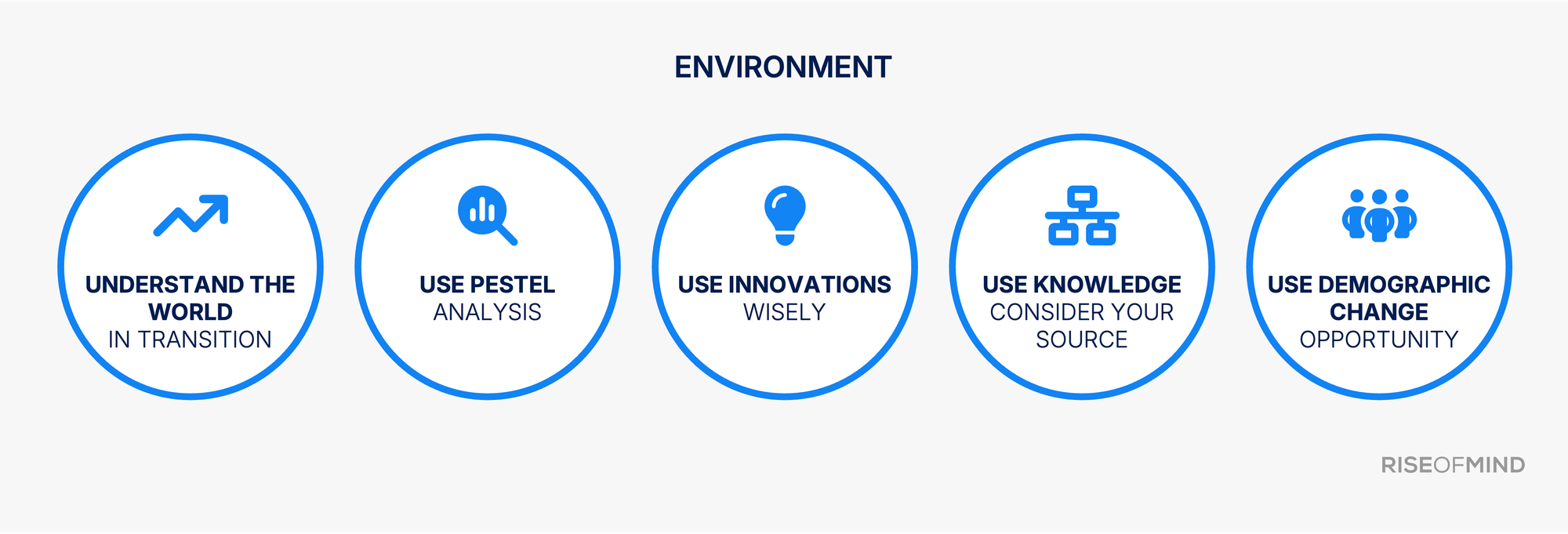Change is constant - but your success depends on how you read the world around you and how you spot opportunities.
The world is changing at lightning speed: AI is transforming professions, geopolitical tensions are shifting markets, and climate change is forcing us to rethink how we live and work. Maybe you know the feeling - reading the morning headlines and wondering how you should move forward. That uncertainty is normal. But hidden within it lies your opportunity.
What does “environment” mean for your career success?
Imagine you are the captain of a ship. Your skills and your crew are essential, but without knowing the wind and weather, you won’t navigate successfully.
Your professional environment includes all external factors that influence your success: technological developments, economic trends, social change, political decisions, and environmental challenges.
The five pillars of environmental awareness

1. Understanding the world in transition: Identifying and leveraging megatrends
Fifteen years ago, there was no iPhone. Five years ago, almost no one had heard of ChatGPT. Today’s most influential megatrends are digitalization, globalization, sustainability, new work models, and demographic change. In future articles, we’ll show you how to harness these trends for your success.
2. The PESTEL framework: A strategic guide for your decisions
This proven tool helps you systematically assess your environment:
- Political factors (laws, regulations, funding)
- Economic factors (markets, economic cycles)
- Social factors (value shifts, demographics)
- Technological factors (innovation, digitalization)
- Environmental factors (climate change, sustainability)
- Legal factors (compliance, regulation)
3. Innovation as a growth driver: Gaining an edge through new ideas
Innovation enables entirely new ways of living and working. Remote work tools, AI assistants, blockchain, and green tech all solve specific problems. The real question is: How can you leverage them for your success? What specific problem could you solve today?
4. Mastering the knowledge explosion: Finding the right insights fast
According to R. Buckminster Fuller, the total knowledge of humanity doubled every 12-13 months in 1982. Forecasts - such as IBM’s in the context of digitalization, the Internet of Things, and AI - suggest that in the future, this could happen within hours.
You don’t need to know everything, just how to access the right knowledge. Primary sources, curated content, networked insights, and personal experimentation are your best tools.
5. Turning demographic change into a future opportunity
An aging population creates new markets (the silver economy) and places greater value on experience. Flexible career models and starting a business at 50+ are no longer the exception - they’re part of the new normal.
Your next steps
- Create your environmental map - Identify the factors with the greatest impact on your field.
- Choose three high-quality information sources - Industry news, tech trends, social developments, etc.
- Start an environmental journal - Record weekly observations and review them monthly.
Conclusion: Understand your playing field
The world can seem overwhelming. But while others bury their heads in the sand, you keep a clear view. You’re not a victim of circumstances - you’re the architect of your own future.
In the coming articles, we’ll share inspiring real-world examples, practical analysis tools, trend radar methods, scenario planning techniques, and digital monitoring tools.
Join the RiseOfMind community - subscribe to our newsletter and start actively shaping your future.

